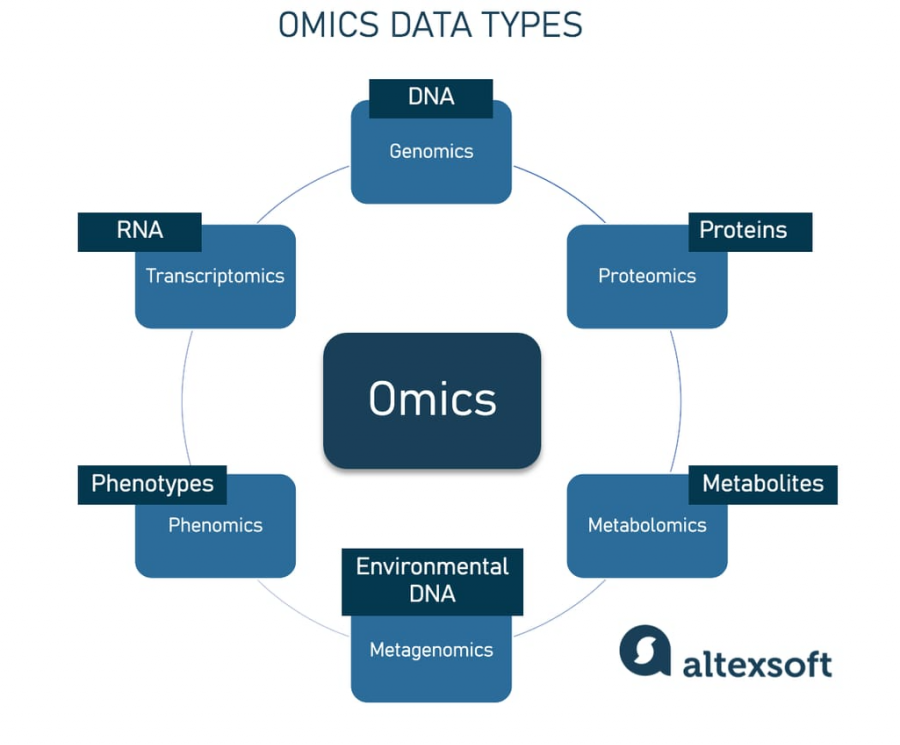

"Omics" refers to various branches of biological science that focus on the collective characterization and quantification of pools of biological molecules that translate into the structure, function, and dynamics of an organism or organisms. These disciplines are typically named with the suffix "-omics." Here are a few examples:
-Genomics: The study of genomes, which is the complete set of DNA within an organism, including all of its genes.
Proteomics: The study of proteomes, which are the entire set of proteins produced or modified by an organism.
Metabolomics: The study of metabolites, the small molecules that are part of the metabolic processes within cells.

Each "-omics" discipline seeks to provide a comprehensive understanding of the biological systems by studying various levels of biological information.
When biology meets IT:
Bioinformatics is a cutting-edge discipline at the intersection of biology and information technology, playing a crucial role in advancing our understanding of biological systems. By integrating computational tools and techniques with biological data, bioinformatics allows scientists to analyze and interpret complex datasets more effectively.

A key application of bioinformatics is in genomics, where it helps manage and decipher the vast amounts of data generated from DNA sequencing. This data analysis is essential for various purposes, such as diagnosing rare genetic conditions, monitoring the spread of infectious diseases, and personalizing treatment plans for cancer patients. By making sense of this data, bioinformatics is driving forward personalized medicine, epidemiology, and a deeper understanding of life at the molecular level.
Meet the bioinformaticians:
Clinical bioinformaticians are essential members of healthcare teams, collaborating with clinical geneticists, laboratory scientists, and other professionals to help diagnose and treat patients, particularly those with rare diseases or cancer. Their primary responsibility is to develop and utilize sophisticated computer programs and software tools to analyze large volumes of genomic data, often generated by next-generation sequencing techniques like whole genome sequencing (WGS) or whole exome sequencing.
The challenge for clinical bioinformaticians is to sift through this massive data to identify patterns, mutations, or other relevant genetic information that can lead to a diagnosis or inform treatment decisions. By filtering and interpreting this data, bioinformaticians provide critical insights that enable personalized and precise medical interventions, turning complex genomic information into actionable clinical solutions.
Applications of Bioinformatics:
Bioinformatics is a versatile and interdisciplinary field with wide-ranging applications across various sectors of life sciences. Here are some key areas where bioinformatics is making a significant impact:
Medicine:
Bioinformatics has revolutionized personalized medicine by enabling the adaptation of treatments to an individual's genetic makeup. This approach enhances the effectiveness of therapies and reduces the risk of adverse effects.
Pharmacology:
In pharmaceutical research, bioinformatics plays a crucial role in combating infectious diseases and developing vaccines. By analyzing biological data, bioinformaticians help identify potential drug targets and optimize drug design.
Genetics:
Bioinformatics is pivotal in gene therapy, especially for diseases caused by mutations in specific genes. Additionally, comparative genomics aids in understanding the evolutionary history of life on Earth, providing insights into how species have adapted over time.
Agriculture:
In agriculture, bioinformatics is applied to proteomics, metabolomics, and genetics to develop stronger crops that are more resistant to drought, pests, and other environmental stresses, thereby improving food security.
Livestock:
By sequencing the genomes of farm animals, bioinformatics helps prevent diseases, improve animal health, and enhance resistance, leading to better productivity and quality of life for livestock.
Waste Management:
Bioinformatics enables the sequencing of the DNA of bacteria and microbes, facilitating their use in environmental applications such as wastewater treatment, radioactive waste disposal, and plastics recycling. This approach helps in identifying and optimizing microbial strains for these purposes, contributing to environmental sustainability.
These applications highlight the transformative power of bioinformatics in addressing complex challenges across different fields.
